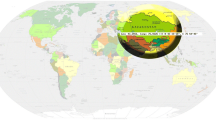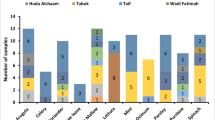Abstract
Pesticide application has become a mandatory requirement of the modern agricultural system, resulting in the objectionable levels of pesticide residues in the treated food commodities and posing health threats to the consumers. This study aimed at optimization and validation of an analytical method which can be reliably applied for routine monitoring of the selected eighteen widely reported pesticides in tomato and eggplant. The principle of quick, easy, cheap, effective, rugged, and safe, i.e., QuEChERS, involving the acetate-buffered extraction followed by cleanup using the primary secondary amines (PSA) was employed. The analytical method was validated at three spiking levels (0.05, 0.01, 0.005 mg/kg) using gas chromatograph-micro electron capture detector (GC-µECD). Gas chromatograph-mass spectrometric detector (GC-MSD) was also used for confirmation and quantification using selective ion monitoring (SIM) mode. The method was applied on fresh samples of tomato (n = 33) and eggplant (n = 27) collected from local markets of Khyber Pakhtunkhwa, Pakistan, in the crop season 2020–2021. Twenty-five (76%) tomato samples and fifteen (56%) eggplant samples were found positive for one or more pesticides. Though the chronic and acute health risk assessments indicate that both of these vegetables are unlikely to pose any unacceptable health threat to their consumers, yet the risks from regular intake of pesticides-contaminated food commodities should be regularly addressed for possible protection of the public health and assurance of safe and consistent agro-trade, alike.


Similar content being viewed by others
Data availability
All the data used in the manuscript is available online.
References
Adenuga AH, Muhammad-Lawal A, Rotimi OA (2013) Economics and technical efficiency of dry season tomato production in selected areas in Kwara State, Nigeria. Agris On-line Pap Econ Inform 5(665-2016–44983):11–19
Afify AS, Abdallah M, Ismail SA, Ataalla M, Abourehab MA, Al-Rashood ST, Ali MA (2022) Development of GC–MS/MS method for environmental monitoring of 49 pesticide residues in food commodities in Al-Rass, Al-Qassim region, Saudi Arabia. Arab J Chem 15(11):104199
Ali M (2018) A hand book for agriculture extension agents on: The pesticides registered with recommendations for safe handling and use in Pakistan. 2nd Edition. Publisher: Dr. Muhammad Anjum Ali, Member plant sciences division. Pakistan Agriculture Research Council
Al-Nasir FM, Jiries AG, Al-Rabadi GJ, Alu’datt MH, Tranchant CC, Al-Dalain SA, Alrabadi N, Madanat OY, Al-Dmour RS (2020) Determination of pesticide residues in selected citrus fruits and vegetables cultivated in the Jordan Valley. LWT Food Sci Technol 123:109005
Amjad A, Randhawa MA, Javed MS, Muhammad Z, Ashraf M, Ahmad Z, Murtaza S (2020) Dietary intake assessment of pyrethroid residues from okra and eggplant grown in peri-urban areas of Punjab, Pakistan. Environ Sci Pollut Res 27:39693–39701
Anastassiades M, Lehotay SJ (2003) Fast and easy multiresidue method employing acetonitrile extraction/partitioning and “dispersive solid-phase extraction” for the determination of pesticide residues in produce. J AOAC Int 86(2):412–431
Ankit Saha L, Kishor V, Bauddh K (2020) Impacts of synthetic pesticides on soil health and non-targeted flora and fauna. Ecological and practical applications for sustainable agriculture, pp 65–88
AOAC-2007.01 (2007) AOAC official method 2007.01: pesticide residues in foods by acetonitrile extraction and partitioning with magnesium sulfate, gas chromatography/mass spectrometry and liquid chromatography/tandem mass spectrometry. Retrieved from: https://nucleus.iaea.org/sites/fcris/Shared%20Documents/SOP/AOAC_2007_01.pdf. Accessed 27 Jan 2020
Bibi A, Rafique N, Khalid S, Samad A, Ahad K, Mehboob F (2022) Method optimization and validation for the routine analysis of multi-class pesticide residues in Kinnow Mandarin and fruit quality evaluation. Food Chem 369:130914
Bibi A, Rafique N, Khalid S, Ahad K, Samad A, Mehboob F (2023) Surveillance of the field-incurred pesticide residues in Kinnow Mandarin and evaluation of acute, chronic and cumulative exposure risks to the consumers
Chiu YH, Sandoval-Insausti H, Ley SH, Bhupathiraju SN, Hauser R, Rimm EB, Manson JE, Sun Q, Chavarro JE (2019) Association between intake of fruits and vegetables by pesticide residue status and coronary heart disease risk. Environ Int 132:105113
EFSA (European Food Safety Authority) (2010) Management of left-censored data in dietary exposure assessment of chemical substances. EFSA J 8(3):1557
EFSA (European Food Safety Authority) (2015) The 2013 European Union report on pesticide residues in food. EFSA J 13(3):4038
EFSA (European Food Safety Authority) (2017) National summary reports on pesticide residue analysis performed in 2015. EFSA J 14(4):1211E
FAO (2018) Food and Agriculture Organization of the United Nations. Pakistan Dietary Guidelines for Better Nutrition. FAO and Ministry of Planning, Development and Reforms. Retrieved from: http://www.fao.org/3/ca1868en/CA1868EN.pdf. Accessed 22 Mar 2022
FAO (2020) Food and Agriculture Organization of the United Nations. FAOSTAT; Food Balances, 2018. Retrieved from: http://www.fao.org/faostat/en/#data/FBS. Accessed 11 Apr 2023
FAO (2022) Food and agriculture organization of the United Nations. Agricultural Production Statistics. 2000–2020. FAOSTAT Analytical Brief Series No. 41. Accessed 11 Apr 2023
FAO (2023) Food and agriculture organization of the United Nations. Tomato; Crop Description. Retrieved from: https://www.fao.org/land-water/databases-and-software/crop-information/tomato/en/#:~:text=Tomato%20(Lycopersicon%20esculentum)%20is%20the,of%2090%20to%20150%20days. Accessed 16 May 2023
FAO and WHO (2021) Report 2021 – Pesticide residues in food. Extra joint FAO/WHO meeting on pesticide residues. Rome. https://doi.org/10.4060/cb6975en. Accessed 11 May 2022
GDD (2018) Global Dietary Database: Tufts University; Gerald J. and Dorothy R. Friedman School of Nutrition Science and Policy. GDD 2018 Final Estimates Download. Retrieved from: https://www.globaldietarydatabase.org/sites/default/files/gdd-data-downloads/202201. Accessed 10 Aug 2021
Hlihor RM, Pogăcean MO, Rosca M, Cozma P, Gavrilescu M (2019) Modelling the behavior of pesticide residues in tomatoes and their associated long-term exposure risks. J Environ Manage 233:523–529
Jardim ANO, Brito AP, van Donkersgoed G, Boon PE, Caldas ED (2018) Dietary Cumulative acute risk assessment of organophosphorus, carbamates and pyrethroids insecticides for the Brazilian population. Food Chem Toxicol 112:108–117
Kaipper BI, Madureira LA, Corseuil HX (2001) Use of activated charcoal in a solid-phase extraction technique for analysis of pesticide residues in tomatoes. J Braz Chem Soc 12:514–518
Kariathi V, Kassim N, Kimanya M (2016) Pesticide exposure from fresh tomatoes and its relationship with pesticide application practices in Meru District. Cogent Food Agric 2(1):1196808
Latif Y, Sherazi STH, Bhanger MI (2011) Assessment of pesticide residues in commonly used vegetables in Hyderabad, Pakistan. Ecotoxicol Environ Saf 74(8):2299–2303
Li Z, Nie J, Yan Z, Cheng Y, Lan F, Huang Y, Chen Q, Zhao X, Li A (2018) A monitoring survey and dietary risk assessment for pesticide residues on peaches in China. Regul Toxicol Pharmacol 97:152–162
Li C, Zhu H, Li C, Qian H, Yao W, Guo Y (2021) The present situation of pesticide residues in china and their removal and transformation during food processing. Food Chem 354:129552
Lozowicka B, Abzeitova E, Sagitov A, Kaczynski P, Toleubayev K, Li A (2015) Studies of pesticide residues in tomatoes and cucumbers from Kazakhstan and the associated health risks. Environ Monit Assess 187:1–19
Nougadère A, Sirot V, Cravedi JP, Vasseur P, Feidt C, Fussell RJ, Hu R, Leblanc J-C, Jean J, Rivière G, Sarda X, Merlo M, Hulin M (2020) Dietary exposure to pesticide residues and associated health risks in infants and young children–results of the French infant total diet study. Environ Int 137:105529
Panno S, Davino S, Caruso AG, Bertacca S, Crnogorac A, Mandić A, Noris E, Matić S (2021) A review of the most common and economically important diseases that undermine the cultivation of tomato crop in the Mediterranean Basin. Agronomy 11(11):2188
Pugalendhi L, Veeraragavathatham D, Natarjan S, Praneetha S (2010) Utilizing wild relative ((Solanum viarum) as resistant source to shoot and fruit borer in Brinjal (Solanum melongena Linn.). Electron J Plant Breed 1(4):643–648
Qasim M, Farooq W, Akhtar W (2018) Preliminary report on the survey of tomato growers in Sindh, Punjab and Balochistan. Policy and institutional reforms to improve horticultural markets in Pakistan (ADP/2014/043), 3
SANTE (2021) SANTE/11312/2021. European Commission Directorate-General for Health and Food Safety. Guidance document on analytical quality control and method validation procedures for pesticides residues and analysis in food and feed. Retrieved from: https://ec.europa.eu/food/system/files/2022-02/pesticides_mrl_guidelines_wrkdoc_2021-11312.pdf. Accessed 23 Feb 2022
Seralini GE, Jungers G (2021) Endocrine disruptors also function as nervous disruptors and can be renamed endocrine and nervous disruptors (ENDs). Toxicol Rep 8:1538–1557
Soydan DK, Turgut N, Yalçın M, Turgut C, Karakuş PBK (2021) Evaluation of pesticide residues in fruits and vegetables from the Aegean region of Turkey and assessment of risk to consumers. Environ Sci Pollut Res 28(22):27511–27519
Turner JA (2018) A world compendium: The pesticide manual, eighteenth edition. British Crop Production Council (BCPC)
UNEP (2019) United Nations Environment Program. All POPs listed in the Stockholm Convention. Retrieved from: http://chm.pops.int/TheConvention/ThePOPs/ListingofPOPs/tabid/2509/Default.aspx. Accessed 18 Apr 2023
WHO (2021) World Health Organization of the United Nations. Chemical safety: pesticides. Retrieved from: https://www.who.int/news-room/q-a-detail/chemical-safety-pesticides. Accessed 1 Sept 2021
Yamada S, Kubo Y, Yamazaki D, Sekino Y, Kanda Y (2017) Chlorpyrifos inhibits neural induction via Mfn1-mediated mitochondrial dysfunction in human induced pluripotent stem cells. Sci Rep 7(1):40925
Ye X, Shao H, Zhou T, Xu J, Cao X, Mo W (2020) Analysis of organochlorine pesticides in tomatoes using a modified QuEChERS method based on N-doped graphitized carbon coupled with GC-MS/MS. Food Anal Methods 13:823–832
Yousafi, Q, Afzal M, Aslam M, Razaq M, Shahid M (2013) Screening of brinjal (Solanum melongena L.) varieties sown in autumn for resistance to cotton jassid, Amrasca bigutulla bigutulla (Ishida). Pak J Zool 45(4)
Yu R, Liu Q, Liu J, Wang Q, Wang Y (2016) Concentrations of organophosphorus pesticides in fresh vegetables and related human health risk assessment in Changchun, Northeast China. Food Control 60:353–360
Zhao P, Huang B, Li Y, Han Y, Zou N, Gu K, Li X, Pan C (2014a) Rapid multiplug filtration cleanup with multiple-walled carbon nanotubes and gas chromatography–triple-quadruple mass spectrometry detection for 186 pesticide residues in tomato and tomato products. J Agric Food Chem 62(17):3710–3725
Zhao M, Zhang Y, Zhuang S, Zhang Q, Lu C, Liu W (2014b) Disruption of the hormonal network and the enantioselectivity of bifenthrin in trophoblast: maternal–fetal health risk of chiral pesticides. Environ Sci Technol 48(14):8109–8116
Acknowledgements
The authors gratefully acknowledge the technical support provided by Pakistan’s Federal Government under the Public Sector Development Program (PSDP-7331) titled “National Pesticide Residues Monitoring System in Pakistan” and also partial support provided by Pakistan’s Khyber Pakhtunkhwa Government under the Annual Development Program (ADP-200014) titled “Surveillance on Pesticide and Fertilizer Adulteration in Khyber Pakhtunkhwa.” The authors are also very grateful to the laboratory’s supporting staff (Mr. Muhammad Asghar, Mr. Muhammad Sadiq, and Mr. Umair Jamal) for all their due and undue support throughout the experimental work.
Funding
This research work was partially funded by Pakistan’s Federal Government under the Public Sector Development Program (PSDP-7331) titled “National Pesticide Residues Monitoring System in Pakistan” and partially by Pakistan’s Khyber Pakhtunkhwa Government under the Annual Development Program (ADP-200014) titled “Surveillance on Pesticide and Fertilizer Adulteration in Khyber Pakhtunkhwa.”
Author information
Authors and Affiliations
Contributions
Conceptualization: FA, AB; method optimization and validation: AB, SRH, AA; samples collection, preparation, and analysis: AB, SRH, AA, AUD, BJ; literature review: AB, AA, MS; Data analysis, results interpretation, and manuscript writing: AB; project supervision: FA.
Corresponding author
Ethics declarations
Ethical approval
The present research paper does not contain any studies with animals and/or humans.
Consent to participate
Not applicable.
Consent for publication
Not applicable.
Competing interests
All the authors declare that there are no financial or proprietary interests in any material discussed in this article.
Additional information
Responsible Editor: Ester Heath
Publisher's Note
Springer Nature remains neutral with regard to jurisdictional claims in published maps and institutional affiliations.
Supplementary Information
Below is the link to the electronic supplementary material.
Rights and permissions
Springer Nature or its licensor (e.g. a society or other partner) holds exclusive rights to this article under a publishing agreement with the author(s) or other rightsholder(s); author self-archiving of the accepted manuscript version of this article is solely governed by the terms of such publishing agreement and applicable law.
About this article
Cite this article
Bibi, A., Anjum, F., Hussain, S.R. et al. Surveillance of pesticide residues in tomato and eggplant and assessment of acute and chronic health risks to the consumers in Pakistan. Environ Sci Pollut Res 31, 6385–6397 (2024). https://doi.org/10.1007/s11356-023-31581-7
Received:
Accepted:
Published:
Issue Date:
DOI: https://doi.org/10.1007/s11356-023-31581-7




